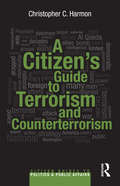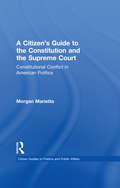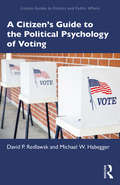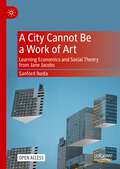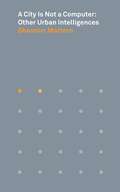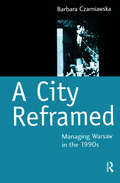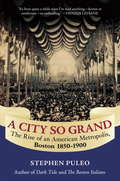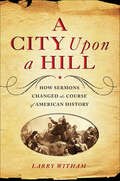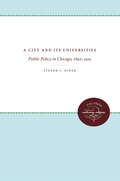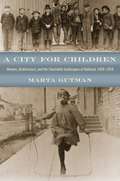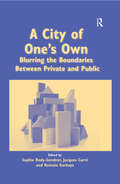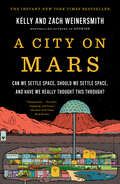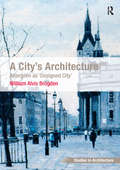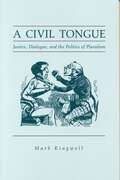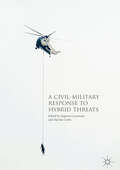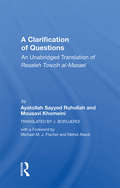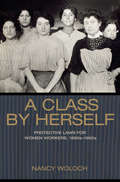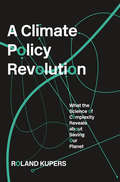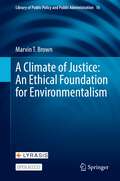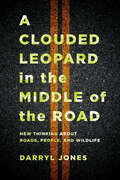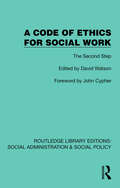- Table View
- List View
A Citizen’s Guide to Terrorism and Counterterrorism
by Christopher C. HarmonThis Citizen’s Guide addresses the public policy issues of terrorism and counterterrorism in the United States after Bin Laden’s death. Written for the thinking citizen and student alike, this succinct and up-to-date book takes a "grand strategy" approach toward terrorism and uses examples and issues drawn from present-day perpetrators and actors. Christopher Harmon, a veteran academic of military theory who has also instructed U.S. and foreign military officers, organizes his book into four sections. He first introduces the problem of America’s continued vulnerability to terrorist attack by reviewing the long line of recent attacks and attempts against the U.S., focusing specifically on New York City. Part II examines the varied ways in which the U.S. is already fighting terrorism, highlighting the labors of diverse experts, government offices, intelligence and military personnel, and foreign allies. The book outlines the various aspects of the U.S. strategy, including intelligence, diplomacy, public diplomacy, economic counterterrorism, and law and law-making. Next, Harmon sketches the prospects for further action, steering clear of simple partisanship and instead listing recommendations with pros and cons and also including factual stories of how individual citizens have made a difference in the national effort against terrorism. This concise book will contribute to our understanding of the problems surrounding terrorism and counterterrorism—and the approaches the United States may take to meet them—in the early 21st century
A Citizen’s Guide to the Constitution and the Supreme Court: Constitutional Conflict in American Politics (Citizen Guides to Politics and Public Affairs)
by Morgan MariettaThe U.S. Constitution is a blueprint for a free society as well as a source of enduring conflict over how that society must be governed. The competing ways of reading our founding document shape the decisions of the Supreme Court, which acts as the final voice on constitutional questions. This breezy, concise guide explains the central conflicts that frame our constitutional controversies, written in clear non-academic language to serve as a resource for engaged citizens, both inside and outside of an academic setting. After covering the main points of conflict in constitutional law, Marietta gives readers an overview of the perspectives from the leading schools of constititional interpretation--textualism, common law constitutionalism, originalism, and living constitutionalism. He then walks through the points of conflict and competing schools of thought in the context of several landmark cases and ends with advice to readers on how to interpret constitutional issues ourselves.
A Citizen’s Guide to the Political Psychology of Voting (Citizen Guides to Politics and Public Affairs)
by David P. Redlawsk Michael W. HabeggerIn the run-up to a contentious 2020 presidential election, the much-maligned American voter may indeed be wondering, “How did we get here?” A Citizen’s Guide to the Political Psychology of Voting offers a way of thinking about how voters make decisions that provides both hope and concern. In many ways, voters may be able to effectively process vast amounts of information in order to decide which candidates to vote for in concert with their ideas, values, and priorities. But human limitations in information processing must give us pause. While we all might think we want to be rational information processors, political psychologists recognize that most of the time we do not have the time or the motivation to do so. The question is, can voters do a “good enough” job even if they fail to account for everything during the campaign? Evidence suggests that they can, but it isn’t easy. Here, Redlawsk and Habegger portray a wide variety of voter styles and approaches—from the most motivated and engaged to the farthest removed and disenchanted—in vignettes that connect the long tradition of voter survey research to real life voting challenges. They explore how voters search for political information and make use of it in evaluating candidates and their positions. Ultimately, they find that American voters are reasonably competent in making well-enough informed vote choices efficiently and responsibly. For citizen voters as well as students and scholars, these results should encourage regular turnout for elections now and in the future.
A City Cannot Be a Work of Art: Learning Economics and Social Theory From Jane Jacobs
by Sanford IkedaThis open access book connects Jane Jacobs's celebrated urban analysis to her ideas on economics and social theory. While Jacobs is a legend in the field of urbanism and famous for challenging and profoundly influencing urban planning and design, her theoretical contributions – although central to her criticisms of and proposals for public policy – are frequently overlooked even by her most enthusiastic admirers. This book argues that Jacobs’s insight that “a city cannot be a work of art” underlies both her ideas on planning and her understanding of economic development and social cooperation. It shows how the theory of the market process and Jacobs’s theory of urban processes are useful complements – an example of what economists and urbanists can learn from each other. This Jacobs-cum-market-process perspective offers new theoretical, historical, and policy analyses of cities, more realistic and coherent than standard accounts by either economists or urbanists.
A City Is Not a Computer: Other Urban Intelligences (Places Books #2)
by Shannon MatternA bold reassessment of "smart cities" that reveals what is lost when we conceive of our urban spaces as computersComputational models of urbanism—smart cities that use data-driven planning and algorithmic administration—promise to deliver new urban efficiencies and conveniences. Yet these models limit our understanding of what we can know about a city. A City Is Not a Computer reveals how cities encompass myriad forms of local and indigenous intelligences and knowledge institutions, arguing that these resources are a vital supplement and corrective to increasingly prevalent algorithmic models.Shannon Mattern begins by examining the ethical and ontological implications of urban technologies and computational models, discussing how they shape and in many cases profoundly limit our engagement with cities. She looks at the methods and underlying assumptions of data-driven urbanism, and demonstrates how the "city-as-computer" metaphor, which undergirds much of today's urban policy and design, reduces place-based knowledge to information processing. Mattern then imagines how we might sustain institutions and infrastructures that constitute more diverse, open, inclusive urban forms. She shows how the public library functions as a steward of urban intelligence, and describes the scales of upkeep needed to sustain a city's many moving parts, from spinning hard drives to bridge repairs.Incorporating insights from urban studies, data science, and media and information studies, A City Is Not a Computer offers a visionary new approach to urban planning and design.
A City Reframed: Managing Warsaw in the 1990's (Cities And Regions Ser. #Vol. 4)
by Barbara CzarniawskaManagement of big cities is a relatively unresearched area, as compared to city planning and city governance. A study of Warsaw city management reveals the transformation process typically found in European countries in political and economic transition. In A City Reframed, Czarniawska conceptualises city management as an "action-net" under transformation, where three types of action are in focus: "muddling through", or coping with daily problems; "reframing", or changing the frame of interpretation of the world in order to take successful action; and "anchoring", the testing of new ideas on potentially involved parties in order to secure cooperation or minimize resistance. "Muddling through" is central to management in Warsaw, as it no doubt has always been: it is this "muddling through" that makes cities function. The specificity of the Warsaw picture is its demand for "reframing" and numerous and varied attempts have been made to achieve a "change of frame". They were sometimes successful, sometimes not, the skill of anchoring only slowly emerging from the most recent past, with the sediments of the old regimes an obvious obstacle. The study pinpoints the phenomena central to the construction of the action-net of city management, and traces its further connections (or lack of such), both temporally and spatially.
A City So Grand
by Stephen PuleoOnce upon a time, "Boston Town" was an insulated New England township. But the community was destined for greatness. Between 1850 and 1900, Boston underwent a stunning metamorphosis to emerge as one of the world's great metropolises-one that achieved national and international prominence in politics, medicine, education, science, social activism, literature, commerce, and transportation. Long before the frustrations of our modern era, in which the notion of accomplishing great things often appears overwhelming or even impossible, Boston distinguished itself in the last half of the nineteenth century by proving it could tackle and overcome the most arduous of challenges and obstacles with repeated-and often resounding-success, becoming a city of vision and daring.In A City So Grand, Stephen Puleo chronicles this remarkable period in Boston's history, in his trademark page-turning style. Our journey begins with the ferocity of the abolitionist movement of the 1850s and ends with the glorious opening of America's first subway station, in 1897. In between we witness the thirty-five-year engineering and city-planning feat of the Back Bay project, Boston's explosion in size through immigration and annexation, the devastating Great Fire of 1872 and subsequent rebuilding of downtown, and Alexander Graham Bell's first telephone utterance in 1876 from his lab at Exeter Place.These lively stories and many more paint an extraordinary portrait of a half century of progress, leadership, and influence that turned a New England town into a world-class city, giving us the Boston we know today.From the Hardcover edition.
A City Transformed: Redevelopment, Race, and Suburbanization in Lancaster, Pennsylvania, 1940-1980
by David SchuylerAs was true of many American cities, Lancaster, Pennsylvania, adopted urban renewal programs in the postwar years to revitalize a downtown that was experiencing economic decline. As the commercial and residential infrastructure of the city decayed, people and jobs migrated to the suburbs. Urban renewal was supposed to make the downtown viable again as a site for both businesses and residences. But as David Schuyler shows in A City Transformed, redevelopment in Lancaster resulted in more failures than successes. Beginning in the 1950s, the Lancaster Redevelopment Authority implemented a comprehensive revitalization program that changed the physical shape of the city. In attempting to solidify the retail functions of the traditional central business district, redevelopment dramatically altered key blocks of the downtown, replacing handsome turn-of-the-century Beaux Arts structures with modernist concrete boxes and a sterile public square. The strategy for eliminating density and blighted buildings resulted in the demolition of whole blocks of dwellings and, perhaps more importantly, destabilized Lancaster's African American community. A City Transformed is a compelling examination of a northern city struggling with its history and the legacy of segregation. But the redevelopment projects undertaken by the city, however ambitious, could not overcome the suburban growth that continues to sprawl over the countryside or the patterns of residential segregation that define city and suburb. When the Redevelopment Authority ceased operating in 1980, its legacy was a city with a declining economy, high levels of poverty and joblessness, and an increasing concentration of racial and ethnic minorities—a city very much at risk. In important ways what happened in Lancaster was the product of federal policies and national trends. As Schuyler observes, Lancaster's experience is the nation's drama played on a local stage.
A City Upon a Hill: How Sermons Changed the Course of American History
by Larry Witham“Witham’s highly readable history of the American sermon strongly bolsters the contention that words change minds and alter the course of events.” —BooklistPivotal moments in U.S. history are indelibly marked by the sermons of the nation’s greatest orators. From colonial times to the present, the sermon has motivated Americans to fight wars as well as fight for peace. Sermons have provoked the mob mentality of witch hunts and blacklists, but they have also stirred activists in the women’s and civil rights movements. A City Upon a Hill tells the story of these powerful words and how they shaped the destiny of a nation.A City Upon a Hill includes the story of Robert Hunt, the first preacher to brave the dangerous sea voyage to Jamestown; Jonathan Mayhew’s “most seditious sermon ever delivered,” which incited Boston’s Stamp Act riots in 1765; early calls for abolition and “Preacher-Captain” Nat Turner’s bloody slave revolt of 1831; Henry Ward Beecher’s sermon at Fort Sumter on the day of Lincoln’s assassination; tent revivalist/prohibitionist Billy Sunday’s “booze sermon”; the challenging words of Martin Luther King Jr., which inspired the civil rights movement; Billy Graham’s moving speeches as “America’s pastor” and spiritual advisor to multiple U.S. presidents; and Jerry Falwell’s legacy of changing the way America does politics.A City Upon a Hill provides a history of the United States as seen through the lens of the preached words—Protestant, Catholic, and Jewish—that inspired independence, constitutional amendments, and military victories, and also stirred our worst prejudices, selfish materialism, and stubborn divisiveness—all in the name of God.
A City and Its Universities: Public Policy in Chicago, 1892-1919
by Steven J. DinerBy focusing on Chicago's first generation of activist professors, Diner shows how modern public policy evolved. Chicago's early academic professionals, believing that they alone could solve the problems of a complex urban society, united to press for reforms in education, criminal justice, social welfare, and municipal administration. By claiming professional autonomy, they established the university firmly in American society and were able to affect it profoundly.Originally published in 1980.A UNC Press Enduring Edition -- UNC Press Enduring Editions use the latest in digital technology to make available again books from our distinguished backlist that were previously out of print. These editions are published unaltered from the original, and are presented in affordable paperback formats, bringing readers both historical and cultural value.
A City for Children: Women, Architecture, and the Charitable Landscapes of Oakland, 1850-1950
by Marta GutmanAmerican cities are constantly being built and rebuilt, resulting in ever-changing skylines and neighborhoods. While the dynamic urban landscapes of New York, Boston, and Chicago have been widely studied, there is much to be gleaned from west coast cities, especially in California, where the migration boom at the end of the nineteenth century permanently changed the urban fabric of these newly diverse, plural metropolises. Ina"A City for Children," Marta Gutman focuses on the use and adaptive reuse of everyday buildings in Oakland, California, to make the city a better place for children. She introduces us to the women who were determined to mitigate the burdens placed on working-class families by an indifferent industrial capitalist economy. Often without the financial means to build from scratch, women did not tend to conceive of urban land as a blank slate to be wiped clean for development. Instead, Gutman shows how, over and over, women turned private houses in Oakland into orphanages, kindergartens, settlement houses, and day care centers, and in the process built the charitable landscapeOCoa network of places that was critical for the betterment of children, families, and public life. a The industrial landscape of Oakland, riddled with the effects of social inequalities and racial prejudices, is not a neutral backdrop in GutmanOCOs story but an active player. Spanning one hundred years of history, a"A City for Childrena"provides a compelling model for building urban institutions and demonstrates that children, women, charity, and incremental construction, renovations, alterations, additions, and repurposed structures are central to the understanding of modern cities. "
A City of One's Own: Blurring the Boundaries Between Private and Public
by Sophie Body-Gendrot Jacques CarréThis book highlights the citizens' continuous participation in a wide range of urban affairs, especially outside institutional frameworks. It brings together an interdisciplinary team of French, British and American academics who examine the long and rich history of participation or partnership in British and American urban life (with additional reference to France), showing that both private interests and community groups have long been involved in local policies. Utilizing the concept of governance as the main theoretical framework, the book explores how Western governments and local authorities have negotiated the difficult task of defining the borders between the territories of private and public actors and also in defining the boundaries of state intervention and public interest. Focusing on the blurring of these boundaries, this book presents a re-examination of how cities were developed, both past and present.
A City on Mars: Can we settle space, should we settle space, and have we really thought this through?
by Kelly Weinersmith Zach Weinersmith* THE INSTANT NEW YORK TIMES BESTSELLER * Winner of the Hugo Award * Scientific American&’s #1 Book for 2023 * Winner of Royal Society's Trivedi Prize * A Guardian Best Book of 2024 * A New York Times Book Review Editors' Choice * A Times Best Science and Environment Book of 2023 * A Tor.com Best Book of 2023 *&“Exceptional. . . Forceful, engaging and funny . . . This book will make you happy to live on this planet — a good thing, because you&’re not leaving anytime soon.&” —New York Times Book ReviewFrom the bestselling authors of Soonish, a brilliant and hilarious off-world investigation into space settlementEARTH IS NOT WELL. The promise of starting life anew somewhere far, far away—no climate change, no war, no doomscrolling—beckons, and settling the stars finally seems within our grasp. Or is it? Critically acclaimed, bestselling authors Kelly and Zach Weinersmith set out to write the essential guide to a glorious future of space settlements, but after years of research, they aren&’t so sure it&’s a good idea. Space technologies and space businesses are progressing fast, but we lack the knowledge needed to have space kids, build space farms, and create space nations in a way that doesn&’t spark conflict back home. In a world hurtling toward human expansion into space, A City on Mars investigates whether the dream of new worlds won&’t create nightmares, both for settlers and the people they leave behind. In the process, the Weinersmiths answer every question about space you&’ve ever wondered about, and many you&’ve never considered:Can you make babies in space? Should corporations govern space settlements? What about space war? Are we headed for a housing crisis on the Moon&’s Peaks of Eternal Light—and what happens if you&’re left in the Craters of Eternal Darkness? Why do astronauts love taco sauce? Speaking of meals, what&’s the legal status of space cannibalism?With deep expertise, a winning sense of humor, and art from the beloved creator of Saturday Morning Breakfast Cereal, the Weinersmiths investigate per-haps the biggest questions humanity will ever ask itself—whether and how to become multiplanetary.Get in, we&’re going to Mars.
A City's Architecture: Aberdeen as 'Designed City' (Ashgate Studies in Architecture)
by William Alvis BrogdenWhen considering the successful design of cities, the focus tends to be on famous examples such as Paris or Rome, with equally successful but smaller and more remote examples being ignored. In addition, the more diffuse patterns of settlement of the north and western parts of Europe are hardly considered at all in comparison to the tightly formed urban centres of the Mediterranean. However, the diffuse town/region is typical of our time, whatever the location. By analysing the development of a successful small city of ancient foundation which grew from a diffuse long settled and dense landscape, then demonstrated a slow growth as a tight urban form before an early adoption of the designed landscape as "town" lessons can be learned. These lessons may be useful in addressing the nature and growth of any city or city/region. The story of Aberdeen is just such an example. Not only are the materials for its long history present, its relations and concerns with the wider world are also well attested, and many of the ideas which directed or significantly impinged on the design of cities were tested there, or had their origin there. As its form accumulated and developed over such a long time Aberdeen also suggests the idea of an architecture of the city. This book examines the development and design of a city from three inescapable aspects: its location and character of the landscape; its own particular history of development; and its cultural responses to various waves of thought.
A Civil Society?: Collective Actors in Canadian Political Life, Second Edition
by Miriam SmithA Civil Society? surveys the main approaches to the study of group politics in Canada, with a strong comparative perspective. Unique to this brief and accessible text is a comprehensive theoretical framework that helps students evaluate policy areas surveyed in the book, while also pointing them toward future study. This new edition opens with a discussion of power, political institutions, and identity. It goes on to explore group and social movement activity across a range of institutions including the House of Commons, the bureaucracy, and the courts as well as mobilization through social media and the electoral system. Throughout, Smith systematically integrates consideration of the role of gender, racialization, and indigeneity in contemporary Canadian group and movement politics.
A Civil Tongue: Justice, Dialogue, and the Politics of Pluralism (G - Reference, Information and Interdisciplinary Subjects)
by Mark KingwellThis book is about a widely shared desire: the desire among citizens for a vibrant and effective social discourse of legitimation. It therefore begins with the conviction that what political philosophy can provide citizens is not further theories of the good life but instead directions for talking about how to justify the choices they make—or, in brief, "just talking."As part of the general trend away from the aridity of Kantian universalism in political philosophy, thinkers as diverse as Bruce Ackerman, Jürgen Habermas, Alasdair MacIntyre, and Richard Rorty have taken a "dialogic turn" that seeks to understand the determination of principles of justice as a cooperative task, achieved in some kind of social dialogue among real citizens. In one way or another, however, each of these different variations on the dialogic model fail to provide fully satisfactory answers, Mark Kingwell shows. Drawing on their strengths, he presents another model he calls "justice as civility," which makes original use of the popular literature on etiquette and work in sociolinguistics to develop a more adequate theory of dialogic justice.
A Civil-Military Response to Hybrid Threats
by Eugenio Cusumano Marian CorbeThis edited volume provides scholars and practitioners with an in-depth examination of the role of civil-military cooperation in addressing hybrid threats. As they combine the simultaneous employment of conventional and non-conventional tools and target not only military objectives but governments and societies at large, hybrid threats cannot be countered solely by military means, but require an equally inclusive response encompassing a wide range of military and civilian actors. This book, which combines the perspectives of academics, military officers, and officials from international and non-governmental organisations, resorts to different case studies to illustrate the importance of civil-military cooperation in enhancing the resilience of NATO members and partners against a wide range of societal destabilization strategies, thereby contributing to the formulation of a civil-military response to hybrid threats.
A Clarification Of Questions: An Unabridged Translation Of Resaleh Towzih Al-masael
by Ruhollah (ayatollah) KhomeiniThis unabridged translation of Ayatollah Khomeini's A Clarification of Questions provides a unique picture of the belief structure of Shi'ism. A compendium of 3000 "problems," Khomeini's treatise is intended to guide laymen in their religious duties, as well as to cover all of life's questions and needs, from personal hygiene and ritu
A Class by Herself: Protective Laws for Women Workers, 1890s-1990s
by Nancy WolochA Class by Herself explores the historical role and influence of protective legislation for American women workers, both as a step toward modern labor standards and as a barrier to equal rights. Spanning the twentieth century, the book tracks the rise and fall of women-only state protective laws--such as maximum hour laws, minimum wage laws, and night work laws--from their roots in progressive reform through the passage of New Deal labor law to the feminist attack on single-sex protective laws in the 1960s and 1970s. Nancy Woloch considers the network of institutions that promoted women-only protective laws, such as the National Consumers' League and the federal Women's Bureau; the global context in which the laws arose; the challenges that proponents faced; the rationales they espoused; the opposition that evolved; the impact of protective laws in ever-changing circumstances; and their dismantling in the wake of Title VII of the Civil Rights Act of 1964. Above all, Woloch examines the constitutional conversation that the laws provoked--the debates that arose in the courts and in the women's movement. Protective laws set precedents that led to the Fair Labor Standards Act of 1938 and to current labor law; they also sustained a tradition of gendered law that abridged citizenship and impeded equality for much of the century. Drawing on decades of scholarship, institutional and legal records, and personal accounts, A Class by Herself sets forth a new narrative about the tensions inherent in women-only protective labor laws and their consequences.
A Clear Case of Genius: Room 40's Code-Breaking Pioneer
by Nigel West Philip Vickers Reginald HallIN 1933 the Admiralty banned ‘Blinker’ Hall from publishing his autobiography, but here, for the first time, those chapters that survived are presented in full. See what the renowned spymaster had to say about the British Naval Intelligence – the pinnacle of the world’s secret intelligence services. He explores the function of secret intelligence in wartime, censorship, subterfuge, the significance of Churchill in the Dardanelles campaign, the Zimmermann Telegram, the USA’s entry to the First World War and more. With supporting text and images by Philip Vickers and a foreword by expert author Nigel West, A Clear Case of Genius provides a unique insight into the thinking of one of Britain’s pioneering intelligence leaders.
A Climate Policy Revolution: What the Science of Complexity Reveals about Saving Our Planet
by Roland KupersHumanity’s best hope for confronting the looming climate crisis rests with the new science of complexity. The sheer complexity of climate change stops most solutions in their tracks. How do we give up fossil fuels when energy is connected to everything, from great-power contests to the value of your pension? Global economic growth depends on consumption, but that also produces the garbage now choking the oceans. To give up cars, coal, or meat would upend industries and entire ways of life. Faced with seemingly impossible tradeoffs, politicians dither and economists offer solutions at the margins, all while we flirt with the sixth extinction. That’s why humanity’s last best hope is the young science of complex systems. Quitting coal, making autonomous cars ubiquitous, ending the middle-class addiction to consumption: all necessary to head off climate catastrophe, all deemed fantasies by pundits and policymakers, and all plausible in a complex systems view. Roland Kupers shows how we have already broken the interwoven path dependencies that make fundamental change so daunting. Consider the mid-2000s, when, against all predictions, the United States rapidly switched from a reliance on coal primarily to natural gas. The change required targeted regulations, a few lone investors, independent researchers, and generous technology subsidies. But in a stunningly short period of time, shale oil nudged out coal, and carbon dioxide emissions dropped by 10 percent. Kupers shows how to replicate such patterns in order to improve transit, reduce plastics consumption, and temper the environmental impact of middle-class diets. Whether dissecting China’s Ecological Civilization or the United States’ Green New Deal, Kupers describes what’s folly, what’s possible, and which solutions just might work.
A Climate of Justice: An Ethical Foundation for Environmentalism (Library of Public Policy and Public Administration #16)
by Marvin T. BrownThis open access book helps readers combine history, politics, and ethics to address the most pressing problem facing the world today: environmental survival. In A Climate of Justice, Marvin Brown connects the environmental crisis to basic questions of economic, social, and racial justice. Brown shows how our current social climate maintains systemic injustices, and he uncovers resources for change through a civic ethics of repair and reciprocity. A must-read for researchers and educators in the area of environmental ethics and those teaching courses in the fields of public policy and environmental sustainability. With the support of more than 30 libraries, the LYRASIS United Nations Sustainable Development Goals Fund has enabled this publication related to SDG13 (Climate Action) to be available fully open access.
A Climate of Risk: Precautionary Principles, Catastrophes, and Climate Change (Environmental Politics)
by Lauren Hartzell-NicholsWe are living in a climate of risk. Our way of life imposes risks on ourselves and others. We are causing climatic changes that have the potential to change radically the conditions under which both we – the present generation – and future generations will live. While we are now quite certain that climate change is happening, we are unsure of exactly what will happen and when, given different emissions and policy scenarios. We are therefore in a position where we must decide what to do about the risks climate change threatens in the face of a range of uncertainties In this book, Lauren Hartzell-Nichols provides guidance in the face of this uncertainty by offering an in-depth discussion of how and why we ought to take a precautionary approach to climate policy, namely by appeal to a Catastrophic Precautionary Principle and Catastrophic Precautionary Decision-Making Framework. By examining the way in which climate change is harmful, Hartzell-Nichols shows how precaution does have a meaningful role to play in moving climate policy forward if we reconsider what precaution is about before too quickly appealing to precaution as a reason or justification for action. A Climate of Risk takes a philosophically grounded, interdisciplinary approach that will appeal to a broad scholarly and policy-oriented audience. Hartzell-Nichols’s reinterpretation of the precautionary principle enables precaution to be more effectively leveraged as a driver of action on climate change.
A Clouded Leopard in the Middle of the Road: New Thinking about Roads, People, and Wildlife
by Darryl JonesA Clouded Leopard in the Middle of the Road is an eye-opening introduction to the ecological impacts of roads. Drawing on over ten years of active engagement in the field of road ecology, Darryl Jones sheds light on the challenges roads pose to wildlife—and the solutions taken to address them. One of the most ubiquitous indicators of human activity, roads typically promise development and prosperity. Yet they carry with them the threat of disruption to both human and animal lives. Jones surveys the myriad, innovative ways stakeholders across the world have sought to reduce animal-vehicle collisions and minimize road-crossing risks for wildlife, including efforts undertaken at the famed fauna overpasses of Banff National Park, the Singapore Eco-Link, "tunnels of love" in the Australian Alps, and others. Along the way, he acquaints readers with concepts and research in road ecology, describing the field's origins and future directions. Engaging and accessible, A Clouded Leopard in the Middle of the Road brings to the foreground an often-overlooked facet of humanity's footprint on earth.
A Code of Ethics for Social Work: The Second Step (Routledge Library Editions: Social Administration & Social Policy)
by David WatsonOriginally published in 1985 the discussions in this book open up a series of important issues for the ethical practice of social work, including questions about the proper relations between personal and professional values, professional responsibility, relations between professionals and their employers, the rights of clients and the education appropriate to ethical social work practice.
